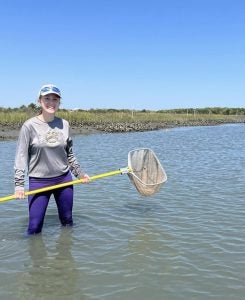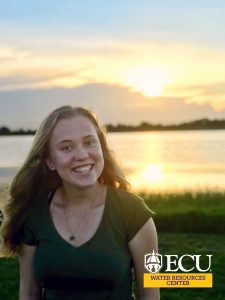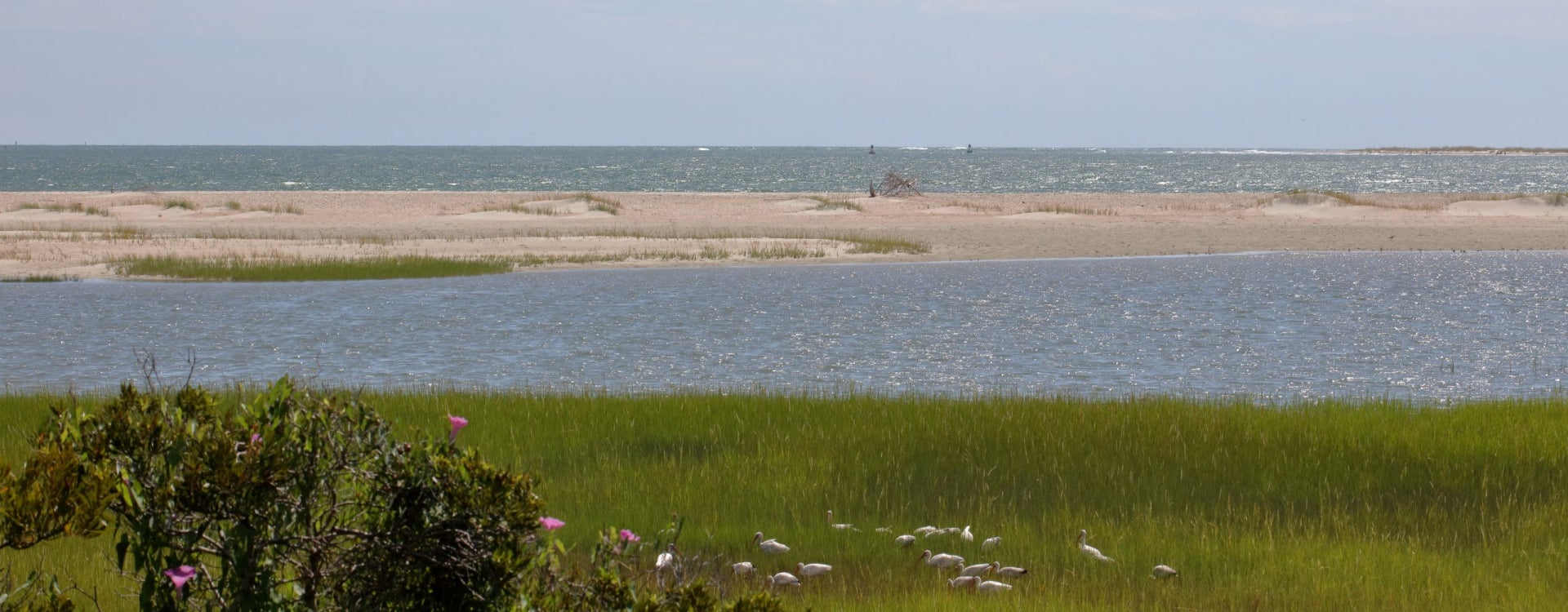Water Scholar Awardee Spring 2023: Grace Loonam
"Using parasite diversity and reef complexity as indicators of restoration success in Carrot Island oyster populations and nearby reefs"
Grace Loonam grew up in South Florida and got to learn more about oyster restoration while living on the coast. Her interests lay in the coastal environment, as well as in biodiversity restoration efforts.
As a first-year master’s student in biology at East Carolina University, Loonam uses her Water Scholar Spring 2023 project: “Using parasite diversity and reef complexity as indicators of restoration success in Carrot Island oyster populations and nearby reefs,” as the foundation of her thesis.
When she was studying at George Mason University in Fairfax, Virginia for her bachelor’s degree, Loonam said, she was working with a mentor and one of her collaborators. She said they worked on a couple of projects together until the collaborator asked her if she wanted to come to ECU for graduate school.
“I was going to wait to start with grad school, but then this opportunity came up,” Loonam said. “I was able to start this project and it was something I haven’t done before. I thought it was a good way to get started with my research on restoration efforts.”
When her mentor mentioned the Water Resources Center offers awards for water studies projects, Loonam said, she thought it was a good idea to apply for it. She said the process has taught her how to practice writing proposals, as well as how to start growing her network.
Loonam said her project is based on earlier research from a past student at ECU, Chris Moore. His research, she said, was an initial restoration effort in 2018 to help get back some of the oyster reefs around Carrot Island near Beaufort, North Carolina.
“There, he was trying a couple of different ways to restore oysters,” Loonam said. “He used a brand-new biodegradable substrate called Oyster Catcher TM and they tried it out alongside a particular method that is composed of less biodegradable components. That’s how he grouped the oysters together and that’s how they can come and grow.”
Loonam said he evaluated the range of species recruited to each habitat patch of oyster reefs and put out the passive samplers nearby to collect different organisms, such as fish, crabs, or snails visiting the reefs. These samplers, she said, are made from milk crates, filled up with oyster shells, and will eventually be strapped down in a reef next to the research site.
The oyster samplers will then remain on the site for about six weeks, Loonam said, to allow more organisms to come and visit the oyster reefs. She said this can indicate when different organisms are using the reefs at various time points in the summer and fall. Once they were ready, Loonam said, Moore looked at what organisms were with the oysters when they were pulled out of the water.
Another method used for oyster restoration, she said, is the oyster bag method. With this method though, Loonam said, there might be the possibility of microplastics getting out into the environment.
“He was basically trying to see what the biodiversity looks like in those passive samplers,” Loonam said. “There were a bunch of different species in it like fish, crabs, little worms, or other invertebrates. With that, he looked at the different methods and compared them to one another. He also looked at the parasites after he dissected the fish, crabs, and snails. Sometimes parasites can be good indicators of the biodiversity that wasn’t caught.”

Grace Loonam doing fieldwork for her project at Carrot Island near Beaufort, North Carolina (Contributed photo).
With her Water Scholar project, she said, she will follow up on Moore’s project at Carrot Island. After five years of the initial project, Loonam said, she will use the same method and compare the data outcomes with Moore’s.
The money she received from the Water Resources Center, she said, is mainly going towards rebuilding the samplers, buying supplies to secure them, as well as gas and boating costs.
“My goal with this project is to add some different things to it, so it’ll be a unique project for myself,” Loonam said. “I will also be looking at wave energy parameters and how many invasive species there are around the oysters.”
The project, she said, will take place over the course of the summer and a little bit into the fall. The reason behind this period is better population growth during these seasons and to include a bit of the main hurricane season, Loonam said.
Since she is only in the first year of her graduate studies, she said, she will be working on the project for the remainder of her time at ECU. Once she finishes her degree, Loonam said, she would like to continue a career in biodiversity restoration.
“In terms of going forward, I would really like to keep going along using what I have learned about restoring systems,” Loonam said. “I’d love to eventually be a professor, or work for a government agency, or even do more research. I’m more interested in the process of doing a couple of different things (related to restoration) than pursuing just one specific kind of career.”
Even though working with oysters can become a difficult task, Loonam said, it fills her with excitement and passion for other research projects. She said she hopes she will be able to teach others about what she knows in the future.

About Me
Name: Grace Loonam
Age: 23
College: Thomas Harriot College of Arts & Sciences
Classification/Focus: First-year master’s student in Biology with a focus on Environmental and Organismic Biology
Hometown: Boca Raton, Florida
Bachelor of Science: Environmental Science with a concentration in Ecological Science and a minor in Conservation Studies
Dream job: Biodiversity restoration
